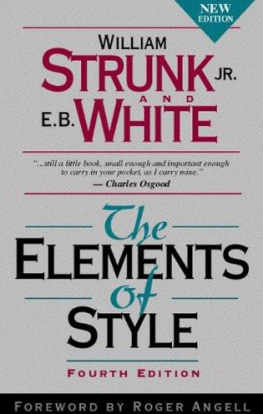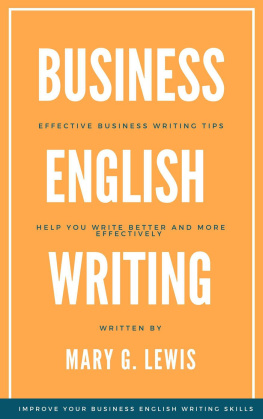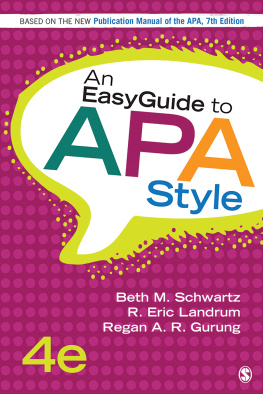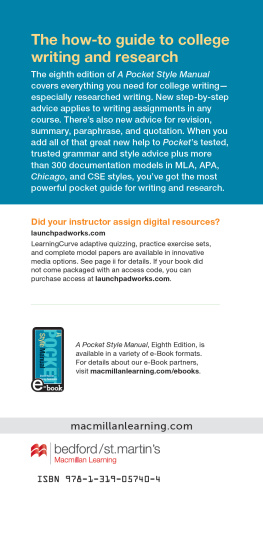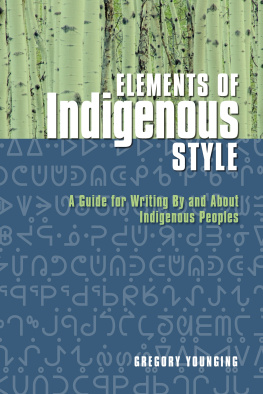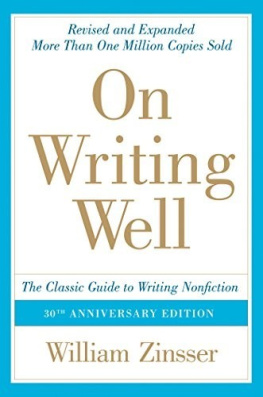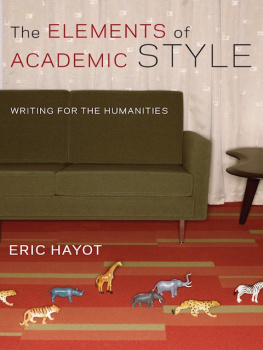
2
OLIVER STRUNK: 'THE ELEMENTS OF STYLE' (4th edition)
First published in 1935, Copyright Oliver Strunk
Last Revision: William Strunk Jr. and Edward A. Tenney, 2000
Earlier editions: Macmillan Publishing Co., Inc., 1959, 1972
Copyright 2000, 1979, ALLYN & BACON, 'A Pearson Education Company'
Introduction - E. B. White, 1979 & 'The New Yorker Magazine', 1957
Foreword by Roger Angell, Afterward by Charles Osgood,
Glossary prepared by Robert DiYanni
ISBN 0-205-30902-X (paperback), ISBN 0-205-31342-6 (casebound).
________
Machine-readable version and checking: O. Dag
E-mail: dag@orwell.ru
URL: http://orwell.ru/library/others/style/
Last modified on April, 2003.
3
The Elements of Style
Oliver Strunk
Contents
1. Form the possessive singular of nouns by adding 's. 1
2. In a series of three or more terms with a single conjunction, use a comma after each term except the last. 2
3. Enclose parenthetic expressions between commas. 2
4. Place a comma before a conjunction introducing an independent clause. 5
5. Do not join independent clauses with a comma. 5
6. Do not break sentences in two. 7
7. Use a colon after an independent clause to introduce a list of particulars, an appositive, an amplification, or an illustrative quotation. 7
8. Use a dash to set off an abrupt break or interruption and to announce a long appositive or summary. 9
9. The number of the subject determines the number of the verb. 9
10. Use the proper case of pronoun. 11
11. A participial phrase at the beginning of a sentence must refer to the grammatical subject. 13
12. Choose a suitable design and hold to it. 15
13. Make the paragraph the unit of composition. 15
14. Use the active voice. 18
15. Put statements in positive form. 19
16. Use definite, specific, concrete language. 21
4
17. Omit needless words. 23
18. Avoid a succession of loose sentences. 25
19. Express coordinate ideas in similar form. 26
20. Keep related words together. 28
21. In summaries, keep to one tense. 31
22. Place the emphatic words of a sentence at the end. 32
1. Place yourself in the background. 70
2. Write in a way that comes naturally. 70
3. Work from a suitable design. 70
4. Write with nouns and verbs. 71
5. Revise and rewrite. 72
6. Do not overwrite. 72
7. Do not overstate. 73
8. Avoid the use of qualifiers. 73
9. Do not affect a breezy manner. 73
10. Use orthodox spelling. 74
11. Do not explain too much. 75
12. Do not construct awkward adverbs. 75
13. Make sure the reader knows who is speaking. 76
14. Avoid fancy words. 76
15. Do not use dialect unless your ear is good. 78
16. Be clear. 79
17. Do not inject opinion. 79
18. Use figures of speech sparingly. 80
19. Do not take shortcuts at the cost of clarity. 80
20. Avoid foreign languages. 81
21. Prefer the standard to the offbeat. 81
5
Foreword*
THE FIRST writer I watched at work was my stepfather, E. B. White. Each Tuesday morning, he would close his study door and sit down to write the "Notes and Comment"
page for The New Yorker. The task was familiar to him he was required to file a few hundred words of editorial or personal commentary on some topic in or out of the news that week but the sounds of his typewriter from his room came in hesitant bursts, with long silences in between. Hours went by. Summoned at last for lunch, he was silent and preoccupied, and soon excused himself to get back to the job. When the copy went off at last, in the afternoon RFD pouch we were in Maine, a day's mail away from New York he rarely seemed satisfied. "It isn't good enough," he said sometimes. "I wish it were better."
Writing is hard, even for authors who do it all the time. Less frequent practitioners the job applicant; the business executive with an annual report to get out; the high school senior with a Faulkner assignment; the graduate-school student with her thesis proposal; the writer of a letter of condolence often get stuck in an awkward passage or find a muddle on their screens, and then blame themselves. What should be easy and flowing looks tangled or feeble or overblown not what was meant at all. What's wrong with me, each one thinks. Why can't I get this right?
It was this recurring question, put to himself, that must have inspired White to revive and add to a textbook by an English professor of his, Will Strunk Jr., that he had first read in college, and to get it published. The result, this quiet book, has been in print for forty years, and has offered more than ten million writers a helping hand. White knew that a compendium of specific tips about singular and plural verbs, parentheses, the "that" "which" scuffle, and many others could clear up a recalcitrant sentence or subclause when quickly reconsulted, and that the larger principles needed to be kept in plain sight, like a wall sampler.
How simple they look, set down here in White's last chapter: "Write in a way that comes naturally," "Revise and rewrite," "Do not explain too much," and the rest; above all, the cleansing, clarion "Be clear." How often I have turned to them, in the book or in my mind, while trying to start or unblock or revise some piece of my own writing! They help they really do. They work. They are the way.
E. B. White's prose is celebrated for its ease and clarity just think of Charlotte's Web
but maintaining this standard required endless attention. When the new issue of The New 6
Yorker turned up in Maine, I sometimes saw him reading his "Comment" piece over to himself, with only a slightly different expression than the one he'd worn on the day it went off. Well, O.K., he seemed to be saying. At least I got the elements right.
This edition has been modestly updated, with word processors and air conditioners making their first appearance among White's references, and with a light redistribution of genders to permit a feminine pronoun or female farmer to take their places among the males who once innocently served him. Sylvia Plath has knocked Keats out of the box, and I notice that "America" has become "this country" in a sample text, to forestall a subsequent and possibly demeaning "she" in the same paragraph. What is not here is anything about E-mail the rules-free, lower-case flow that cheerfully keeps us in touch these days. E-mail is conversation, and it may be replacing the sweet and endless talking we once sustained (and tucked away) within the informal letter. But we are all writers and readers as well as communicators, with the need at times to please and satisfy ourselves (as White put it) with the clear and almost perfect thought.
Roger Angell
7
Introduction*
AT THE close of the first World War, when I was a student at Cornell, I took a course called English 8. My professor was William Strunk Jr. A textbook required for the course was a slim volume called The Elements of Style, whose author was the professor himself.
The year was 1919. The book was known on the campus in those days as "the little book,"
with the stress on the word "little." It had been privately printed by the author.
(* E. B. White wrote this introduction for the 1979 edition.) I passed the course, graduated from the university, and forgot the book but not the professor. Some thirty-eight years later, the book bobbed up again in my life when Macmillan commissioned me to revise it for the college market and the general trade.
Next page
